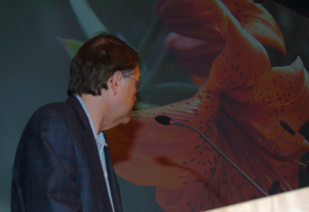Calit2 UCSD Welcomes IEEE ISM2006 Attendees
By Maureen C. Curran
|
San Diego, CA, December 20, 2006 -- The UCSD division of Calit2 hosted demonstrations of its extreme multimedia technologies to attendees of the IEEE International Symposium on Multimedia (ISM2006), which took place in San Diego last week.
"I am very impressed," said Alexander Loui of the Kodak Research Lab, "looking at the resolution 4K by 2K is just stunning." He added: "This is a nice facility to have in the U.S., with this capability of displaying very high resolution data. Hopefully we will learn more about its applications for the future. I am glad to have had the opportunity to visit here."
Calit2 was a special event in the program agenda for the three-day multimedia symposium which was held at nearby Mission Bay. More than 80 conference attendees from organizations all over the world made the trip from Mission Bay to Atkinson Hall.
The tour was arranged by Phillip Chen-Yu Sheu, a Calit2 academic participant at UC Irvine, who was the symposium's local organizer. "I visited Calt2 at UCSD about a year ago and Larry showed me the new technologies -- I was very impressed," he explained, "that's why we brought the group here, so that they can all share the same experience as I had." They did.
|
A variety of live, real-time streaming visualizations with resolutions of 3840x2160, or 8 megapixels at 24 frames per second, were shown using the Sony 4K SXRD projection system -- the first 4K projector installed in the U.S., at Calit2 in September 2005 for iGrid. One clip was a scientific visualization of water current flows in Monterey Bay, which were the output of a supercomputer simulation done by Yi Chao at the Jet Propulsion Lab in Pasadena, then sent to the National Center for Supercomputing Applications (NCSA) to be visualized by Donna Cox's team, and then streamed back to Calit2.
"The data is streaming over dedicated one gigabit/s optical light paths from remote OptIPuter disk drives, with the 4K video stream being compressed with JPEG2000," explained Calit2 research scientist Tom DeFanti, "Some clips will be streamed live from NCSA in Illinois over National Lambda Rail; other pieces will be coming from the University of Southern California in Los Angeles over CENIC fiber."
"The 4K video clips rendered in real time were very impressive," said George Wang of California State University, Northridge, who was also an organizer of ISM2006.
"What we are doing here at Calit2," explained Calit2 director Larry Smarr, "is providing access to innovative cyberinfrastructure, like the OptIPuter-connected Sony projection system, to a wide range of disciplinary researchers, who then figure out new uses of the enhanced capability in their field." He continued: "The exquisite detail at this high resolution allows scientists and artists to see aspects of phenomena that they would not otherwise see."
The group was treated to demonstrations of several other of Calit2's cutting-edge multimedia technologies, including 1600x1200 pixel projected stereo video in the multipurpose room and interactive 3-D virtual reality (VR) demonstrations in the immersive visualization lab.
The Varrier display in Calit2's immersive visualization lab was developed by Dan Sandin's team at the University of Illinois's Electronic Visualization Laboratory. The Varrier is a head-tracked, 35-panel tiled display system, which gives the viewer stereoscopic images without the usual glasses needed to experience 3-D imagery. It provides over 40 megapixels to each eye compared to 2 megapixels in standard projected VR. The ISM2006 visitors had an interactive experience of flying around a very high resolution 3-D Mars, including flying through the great canyons or around the large volcano on Mars. The Mars data set consists of 1-kilometer resolution imagery from the Mars Global Surveyor satellite, draped over elevation data provided by laser altimetry from the orbiting satellite.
"It was really great, especially the 3-D display," said Mikko Loytynoja of the University of Oulu in northern Finland. "It's amazing, I'm out of words."
|
Ryoichi Komiya, of the National Institute of Information and Communications Technology (NICT) in Japan enjoyed the demonstrations and found that "the research at Calit2 and UCSD is very interesting." He is also interested in the broader issues presented by technologies such as virtual reality. "All this equipment is very expensive," he pointed out. "How to apply virtual reality and immersive technology to actual society -- actual needs -- is very difficult to determine."
The IEEE International Symposium on Multimedia (ISM2006) is an international forum for researchers to exchange information regarding advances in the state of the art and practice of multimedia computing, as well as to identify the emerging research topics and define the future of multimedia computing.
The international symposium was sponsored by the IEEE Computer Society in cooperation with Calit2, UC San Diego and the European Academy of Sciences.
Related Links
IEEE International Symposium on Multimedia (ISM2006)
OptIPuter
iGrid 2005
Related Articles
Calit2 Goes Hollywood at First Annual CineGrid International Workshop
iGrid IV: Visualization and Collaborative Environments
iGrid Part III: High-Def, Interactive, and Multicast Applications
iGrid Part II: Remote-Control Demonstrations
iGrid to Present Highest-End International Technology and Application Demonstrations
iGrid to Push Edge of Networking Frontier by Demonstrating World?s Most Demanding Applications




